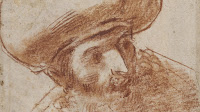I decided to spend Saturday afternoon at one of my favourite Museums in Lisbon, Museu Nacional de Arte Antiga, which had four temporary exhibitions I was keen on seeing. I ended up starting with small collection of red chalk drawings dating back to the 16th -18th century.
It is said that most European artists living in that epoch made use of red chalk, whose colour fluctuates between orange-like shades to a dark brownish red, being able to achieve outstanding results with it. Some years ago I had been to a similar exhibition, but I felt the red chalk drawings sellected for this temporary exhibition were a lot more exquisite.
Because of them being behind glass it was rather difficult to photograph the drawings, so I opted for details, which nevertheless give the viewers an idea of the craft involved.
Male with a turban by Giovani Barbieri (1591-1666)
Virgin and child by Denis Calvaert (1540-1610) on the left. Bacchus and Ceres after Bartholomeus Sprangler (1546-1611) on the right.
Rest on the flight to Egypt by Sébastien Bourdon (1616-1671)
Abraham explaining the machinery of the world by Vieira Lusitano (1699-1783)
The sleep of Antiope by Pierre-Antoine Quillard (1701-1733) on the left. Pastoral scene by Jacques Charlier (1706-1790) on the right.
I then headed to one of the first floor exhibition rooms so as to see the guest work "Adam and Eve" by Jan Gossaert.
Having been a painter in the Antwerp Guild in 1503 not much is known of this unusual Renaissance Nordic painter of Maubeuge (now part of France). What seems to be known though is that in the compositions quite a few mythological subjects abound and that his paintings are marked by a fanciful use of architecture.
The rather small painting pertaining to the Thyssen collection which was in display is said to have been painted shortly after his return from Rome in 1510 and directly based on the famous engraving on the same subject by Dürer. It is almost certain that Gossaert must have become fascinated by the sculptural nature of the bodies, whose poses are basically the same though the background landscape has been entirely changed.
Before heading down onto the ground floor I still had time to visit a third temporary exhibition, this time of faiance linked to the theme of running water. I must say I was mesmerised by the ceiling of the room where it was exhibited in, which was of exquisite beauty. It displays the partial quadratura which was painted by the Tuscan artist Vincenzo Bacherelli (1672-1745) during his stay in Lisbon (1701-1721)
There weren't many ceramic pieces in display but I must confess they were at least two I felt were outstandingly exquisite, one being an aquarium and the other one a small inner fountain.
"Perseus rescuing Andromeda" made by followers of Bernard Palissy (France or Italy - 17th/19th century) on the left. An aquarium made by Real Fábrica de Louça, Lisbon in 1780-1816
(To be continued)


















No comments:
Post a Comment